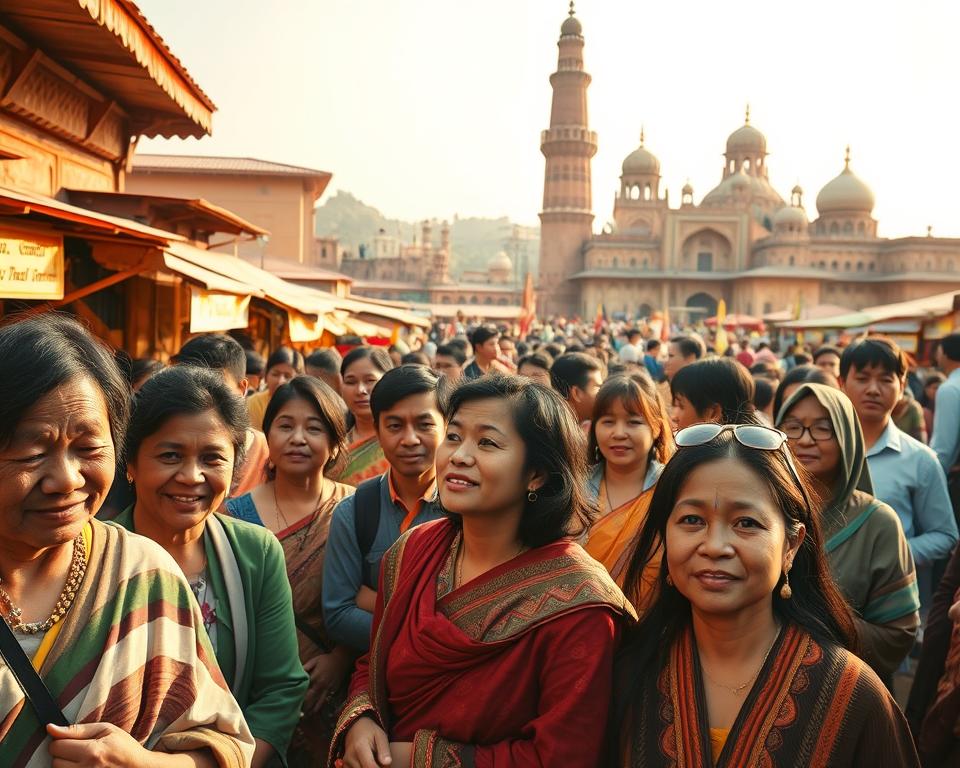Anúncios
Have you ever wondered how a single meal can change the way you see a place? That question lies at the heart of gastronomic tourism, where food leads your curiosity and travel becomes a way to learn.
You’ll explore how markets, street stalls, cooking classes, and festivals connect what you eat with local culture. These activities show how a taste of place can shape your sense of place and broaden the way you travel.
Practical examples make this real: Singapore’s hawker centers and Barcelona’s La Boqueria highlight how vendors and markets draw people to flavors and stories. Companies like Airbnb report strong demand for food experiences, so many travelers now add market visits or classes to their plans.
This guide will set clear expectations and offer updated examples so you can plan responsibly. You’ll learn why people choose certain dishes or activities and how those choices reflect your travel style, while respecting the communities behind the plates.
Introduction
Gastronomic tourism shows how taste shapes the way you see a place.
Anúncios
The World Food Travel Association calls this traveling for a “taste of place” to gain a sense of place. That idea explains why many travelers now ask, “What should I eat here?”
Airbnb reports roughly 30% of Experience bookings are food and drink. This trend shows the role of food in trip planning. Researchers add that taste is the top motivator for food tourists. Cultural experiences and social moments in markets and events follow closely.
The guide ahead explains why taste matters. You will get clear definitions, real examples, and quick tips. That will help you pick dishes and markets that match your style and respect local history and peoples. Use this as a friendly resource while you pair it with local advice when needed.
Anúncios
Gastronomic tourism: meaning, scope, and why it matters
Clear terms help you choose food experiences that fit your interests. Some trips focus on dishes and techniques, while others look at food as part of local life, history, and farming.
Defining the difference in clear terms
culinary tourism usually centers on recipes, cooking techniques, festivals, and tasting events. It’s about what you eat and how dishes are made.
Gastronomic tourism takes a wider view: it links food to history, agricultural practice, and everyday lifestyle. That wider lens shows how ingredients and methods shape regional identity.
Key motivations backed by research
Studies show taste is the top reason people seek food travel, followed by cultural experiences and social moments. Dr. Barry O’Mahony highlights markets, specialty shops, and events as strong draws.
“Taste is the most important motivator, followed by cultural experiences and socialization.”
What counts as a meaningful food experience
Core activities include market tours, street food walks, cooking classes, brewery or winery visits, tastings, and food festivals. These let you see techniques and meet the people behind local cuisines.
- Morning at a farmers’ market
- Hands-on cooking class with local recipes
- Neighborhood food walk guided by residents
Why it matters: these choices can support small producers, preserve heritage and traditions, and boost local development when you travel with respect.
Trends, destinations, and practical ways to experience food travel
Today’s food scene favors guided tastings and market walks that connect you to producers. Airbnb reports about 30% of Experiences bookings are food and drink, which shows steady growth in guided tastings, market tours, and hands-on classes.
What’s new now
Guided small-group tastings and night markets are rising in popularity. Pop-up restaurants and resident-led walks let you meet makers and learn quick tips.
Must-try activities with real-world value
Try experiences that teach and connect. Cooking classes and market walks help you bring simple dishes home. Street food tours and brewery or winery visits offer practical context and tasting notes.
Destination examples that blend culture and cuisine
Barcelona’s La Boqueria shows seasonal cuisines in action. Singapore’s hawker centers mix daily life and flavor at a human scale. These places make events and markets feel like living heritage.
Culture, economy, and heritage preservation
Local activities direct money to small vendors. Choosing resident-led experiences supports independent operators and helps preserve recipes and techniques through public events.
How to choose experiences that fit your style
- Pick small groups for better access to vendors.
- Look for seasonal menus and clear sourcing.
- Favor activities designed by residents or local businesses.
Talk to stall owners, ask about ingredients, and pace your day so each place stays meaningful. These simple filters help you enjoy food tourism and travel with respect.
Designing and marketing better culinary experiences for travelers
Designing great food experiences starts with a clear promise about what guests will taste, learn, and remember. That promise helps you stand out in a crowded destination market and gives tourists a reason to book.

For destinations and businesses: what works now
Focus on a single point of difference and say it plainly. Small, hands-on offerings—market tours, short tastings, and cooking classes—deliver flavor and context.
- Partner locally: work with farms, vendors, and artisans so people see who benefits.
- Keep groups small: short tastings and seasonal menus create deeper connections.
- Use micro-influencers: choose creators who reflect your culture and disclose partnerships.
Responsible, practical planning tips for you
If you’re planning or booking, map the guest journey from discovery to follow-up. Make booking mobile-friendly and clear on meeting points and timing.
“Balance flavor with chances to connect—taste leads, then culture and social moments follow.”
Before you reserve, ask about sourcing, waste practices, and fair pay. Read recent reviews that mention flavor and storytelling. Pick activities that match your energy—one-hour tastings often beat long, rushed tours.
Conclusion
Taste often becomes the clearest way to meet a destination and its people. Food experiences give you many paths to connect with local culture, from markets and street stalls to cooking classes and neighborhood restaurants.
Plan responsibly. Pick small groups, ask about sourcing, and favor hosts who explain techniques and customs. That helps preserve heritage and supports local people.
Use official sources—tourism boards or embassies—for current hours, rules, and safety guidance. Keep expectations flexible. Every food travel experience is unique, and that variety is part of the reward.
Let taste lead, but travel kindly. Seek stories, respect traditions, and choose experiences that leave a real benefit for the place you visit.



